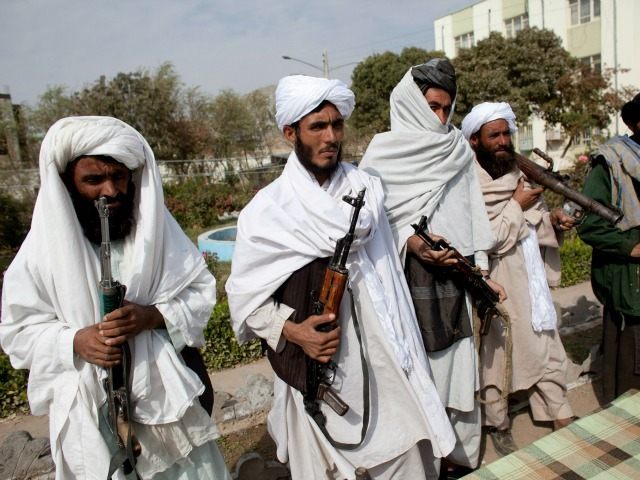WASHINGTON, D.C. — President Obama, in his final State of the Union (SOTU) address delivered Tuesday, only mentioned Afghanistan, home to America’s longest war, once, without highlighting that a resilient Taliban has managed to gain control of more territory than at any time since 2001.
During his SOTU address last year, the President claimed the U.S. “combat mission in Afghanistan is over” as one of his chief foreign policy accomplishments.
“Instead of Americans patrolling the valleys of Afghanistan, we’ve trained their security forces, who have now taken the lead, and we’ve honored our troops’ sacrifice by supporting that country’s first democratic transition,” he added.
Fast forward a year and the Taliban’s reach in Afghanistan is currently greater than at any point since the group was removed from power following the U.S.-led invasion in October 2001.
Moreover, the Islamic State (ISIS/ISIL) established a presence in the Afghanistan region, soon after President Obama’s 2015 State of the Union address. ISIS in Afghanistan is growing, according to Gen. John Campbell, the top commander of NATO and American troops in the country, the Pentagon, and lawmakers who have recently visited the war-torn nation.
Al-Qaeda training camps are also reportedly sprouting across Afghanistan, more than 14 years after U.S. troops were deployed to topple the Taliban regime and pursue al Qaeda after it used Afghanistan as a base for the 9/11 terrorist attacks against the American homeland.
On Tuesday, President Obama did note that instability is plaguing Afghanistan, but he failed to go into specifics about the Taliban resurgence, a rising ISIS, and a resilient al Qaeda that continues to fuel deteriorating security conditions in the country.
“Our foreign policy hast to be focused on the threat from ISIL and al Qaeda, but it can’t stop there. For even without ISIL, even without al Qaeda, instability will continue for decades in many parts of the world — in the Middle East, in Afghanistan, parts of Pakistan, in parts of Central America, in Africa, and Asia,” he said. “Some of these places may become safe havens for new terrorist networks. Others will just fall victim to ethnic conflict, or famine, feeding the next wave of refugees.”
The Washington Post acknowledged that President Obama made the Afghan war his own when he surged the number of American troops there soon after taking office in 2009 and drafted plans in May 2014 to end the conflict definitively.
An estimated 75 percent of all U.S. military deaths and nearly 90 percent of all the injuries in Afghanistan have occurred under President Obama’s watch. That means that, as of mid-October 2015, at least 1,672 U.S. troops had been killed and another 17,425 wounded in Afghanistan since the president was inaugurated for his first term on January 20, 2009.
“In Afghanistan, U.S. officials said, American and allied forces had built up a credible local military and beaten back an entrenched Taliban militancy,” notes the Post. “Today, it is far harder today for Obama to claim victory.”
“In recent months, the Taliban has proved its strength in a series of offensives that have put local forces on their heels and even surprised American military leaders. Late last month, six U.S. troops were killed in a Taliban attack, the most deadly insurgent assault on American service members in year,” it adds. “Just last week, a U.S. soldier was killed during a joint special operations mission in southern Afghanistan.”
Initially, the Pentagon was having a hard time conceding that last week’s operation was proof that the U.S. combat mission in Afghanistan is not over as Obama announced in December 2014.
“As the conflict grinds on, U.S. military commanders are also employing their troops in ways that challenge the administration’s assertion that America’s combat role has come to an end,” reports the Post.
“Since he announced two years ago that he planned to withdraw the last American troops by the end of 2016, Obama has adjusted his Afghanistan withdrawal plan several times, each time leaving a larger force longer to reflect the vulnerability of local forces to Taliban attack,” it continues.
The Pentagon eventually acknowledged that the Jan. 5 operation against the Taliban in southern Afghanistan, which resulted in the death of Staff Sgt. Matthew Q. McClintock, constituted a “combat situation,” but insisted that the American forces have transitioned from a combat mission to a train, advise, and assist (TAA) role.
Two U.S. service members and an Afghan were also injured in the operation.
Currently, there are an estimated 10,000 U.S. troops in Afghanistan, down from a peak of about 100,000 in 2012.
“U.S. officials now suggest their may be further revisions to come, meaning the next U.S. president will make his or her own decisions about how long American military involvement will last,” points out WaPo.
President Obama has decided to bring down the number of U.S. troops to 5,500 by the end of this year, rather than draw down to a Kabul-only U.S. military presence as previously scheduled. The United States is expected to maintain 5,500 U.S. troops in Afghanistan beyond 2016, for an undetermined period of time.

COMMENTS
Please let us know if you're having issues with commenting.